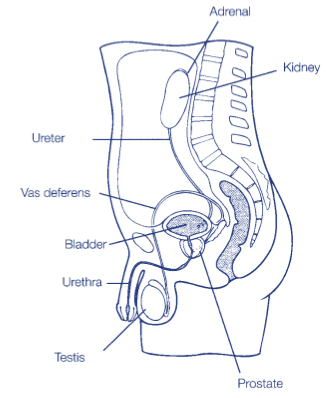- Men
- Bilateral Scrotal Orchidectomy
- Bladder Neck Incision (B.N.I.) and Urethrotomy
- Brachytherapy
- Circumcision
- Cystoscopy
- Flexible Cystoscopy
- Hydrocelectomy Spermatocelectomy & Epididymal Cystectomy
- Inguinal Orchidectomy
- Kidney Cryotherapy
- Laparoscopic Nephrectomy
- Laproscopic Pyeloplasty
- Laser Prostatectomy
- Magnetic Resonance Imaging (MRI) Scan
- Nephrectomy
- Orchidopexy
- Other Services (Men & Women)
- Other Treatments (Men Only)
- Robotic Assisted Laparoscopic Prostatectomy
- Sexual Dysfunction
- Transperineal Ultrasound Guided Prostate Biopsy (TPPB)
- Transrectal Ultrasound & Biopsies of the Prostate
- Transurethral Resection of Bladder Tumour
- Ureteroscopy
- Vasectomy
- Women
- Children
- Clinical Trials
Treatment Process:
Orchidopexy
This information is designed to help you, your family and friends prepare for your surgery. It will also help you plan how to take care of yourself in the weeks following discharge from hospital.
An orchidopexy is an operation that brings a non-descended testicle/s, down into the scrotum. An orchidopexy can be done on one or both sides. When both testicles are brought down this is called a bilateral orchidopexy.
The reason for surgery is that if a non- descended testicle is not brought down into the scrotum before puberty it usually will fail to develop its ability to produce sperm. More importantly, if it remains undescended, there is a slightly increased risk of developing testicular cancer within that testicle.
Treatment
A small incision is made just above the groin on the effected side/s. The testicle is then located and the spermatic cord isolated. Often there is a hernia associated with these undescended testicles and if this is the case, the hernia is also repaired. The testicle is then put down into the scrotum in one of two ways. If the cord is quite short, a special pouch is made in the scrotum to hold the testicle down there. If the cord is long enough, the testicle can be popped into the scrotum and the neck of the scrotum is narrowed by stitching it partly closed so the testicle won’t pop back up. If a pouch has to be made, there will be a small external cut in the scrotum and this will be closed with dissolving stitches also. A dressing would then be placed over the wound/s to protect the incision and aid healing.
Rarely a testicle may not be able to be brought down fully during surgery and a second procedure may need to be planned. The testicle may have such a short cord that the only way to bring it down is to swing it down on the vas deferens, the tube that carries sperm. When this technique is used there is a risk the testicle may die, but hopefully the blood vessels are sufficiently large enough to allow the testicle to survive. If it is not possible to bring a testicle down due to malformation, the testicle would be removed due to the potential risk of cancer. Fortunately, these situations very rarely arise and in the majority of cases surgery is straight forward.
The operation is a day stay procedure, which means no overnight stay is required.
Your Consent
We need permission for the operation to go ahead. Before the consent is signed, it is important that the risks and effects of the operation and anaesthetic are understood. These will be discussed prior to surgery. Should any questions arise after the discussion please feel free to ask the nurse or doctor who would be happy to answer these.
About Your Anaesthetic
Usually nothing is allowed to be eaten or drunk for six hours before surgery. This includes chewing gum and sweets. Exact instructions are given about ‘nil by mouth’ requirements prior to surgery.
There are two main types of anaesthetic used for this surgery;
- General Anaesthetic: Patients are asleep throughout the operation and remember nothing of it. For young children gas is given through a small mask, which puts the child off to sleep, and avoids the need for the insertion of a needle while the child is awake. However, as soon as the child is asleep, a ‘drip’ is put in for safety reasons.
- Regional Anaesthetic e.g. Spinal, Epidural or Caudal: A needle is placed into the back and a solution is injected that numbs the body from the waist down. Patients are awake but maybe sleepy and do not feel the operation. In young children, a general anaesthetic is usually combined with a caudal. This ensures the child is asleep during the operation, but when they wake, the caudal continues to work for several hours blocking the nerve supply to the penis and preventing pain.
Feel free to discuss these options, and any questions with the anaesthetist.
Your Operation
On admission, you will be informed of the approximate time of surgery and preparations will be completed by the nurse so everything is ready for theatre. If a shave of the surgical site is required, this will be done in theatre once your child is asleep.
You and your son would be escorted to the theatre waiting room. Your son would then be taken to theatre and transferred to the operating table. Anaesthetic staff will then apply a mask and attach various monitoring devices. Once all the preparations are complete and the anaesthetic has been given surgery will begin. Depending on what needs to be done the operation usually takes about 30 minutes for a single orchidopexy and up to double this time for a bilateral orchidopexy.
When the operation is completed, your boy will go to the recovery room. You maybe called up to recovery to meet your child if necessary. Your boy will stay in the recovery room only for a short while where he will be cared for until ready to be transferred to the ward.
After Surgery
The nurse will check blood pressure, pulse and wound routinely. A drip maybe present to ensure adequate fluid intake is maintained until your boy is drinking normally. He can usually eat and drink when he returns to the ward.
Once recovered from the anaesthetic your boy will be allowed to be up and about. However he may be a bit wobbly on his feet if he had a caudal anaesthetic so careful supervision will be needed.
Pain relief is given on a regular basis to ensure comfort is maintained. At all times, the nurse is there to help, please ring the bell if assistance is needed and the nurse is not nearby.
Going Home
Once your son has passed urine, is up and about, eating and drinking, he can go home. The nurse gives instructions on whether or not it is necessary to see the surgeon or your sons’ own doctor for follow-up. A discharge information letter is given prior to discharge that contains helpful information for returning home.
The doctor may give a prescription for some antibiotics after the operation. It is important to complete the whole course as instructed, even if everything looks well and it doesn’t look like any more tablets need to be taken. A letter is sent to your sons’ own doctor about the operation and the details of treatment given in hospital.
Once Home
It is important for day stay patients to take things quietly for the rest of the day as the anaesthetic can still have some effects on the body. Your son should take things quietly for the next few days after surgery also.
Regular pain relief can be taken as required to maintain comfort. Advice about pain relief will be given by the nurse prior to discharge. Prindette or Pamol syrup is usually used for children.
Instructions about wound and dressing care will be given by the nurse prior to discharge. The stitches placed during the operation dissolve slowly in the weeks following surgery. Your son will be allowed to shower or bath as usual but soap or powders should not be used directly on the wound until it has fully healed.
Following discharge there will always be some swelling in the region of the scrotum and the testicle may even rise up out of the scrotum partially although it almost always returns.
However if any excessive bleeding or signs of infection appear or your are concerned at all for any reason please see your sons’ own doctor as soon as possible.
While your son is in hospital we will do everything we can to make the stay as comfortable as possible. The nursing and medical staff are always available to help with whatever needs you have. If you are worried about anything before or after the surgery,or if you have any further questions or would like more information, please do not hesitate to ask the nurse who will be more than happy to help.
While you are in hospital, we will do everything we can to make your stay as comfortable as possible. The nursing and medical staff are always available to help with whatever needs you have. If you are worried about anything before or after your surgery, or if you have any further questions or would like more information, please do not hesitate to ask your nurse who will be more than happy to help.
Orchidopexy in adults
Orchidopexy is also performed for boys and men whose testicle/s have descended but continue to intermittently retract back up into the groin. The reason for orchidopexy in this situation is this intermittent retraction of the testicle can cause pain and discomfort and in some cases when a testicle retracts it can turn on itself blocking off its blood supply. This is known as a ‘testicular torsion’. It is an emergency situation because if the blood supply is cut off for too long, the testicle will die. For this reason an orchidopexy is carried out to prevent a torsion of the testicle from occurring.
Some boys or men come into hospital acutely with a torsion of the testicle having never experienced any problems previously with a undescended or retracted testicle. In this situation, emergency surgery is carried out to fix the effected testicle and in most instances the unaffected testicle is also fixed with an orchidopexy to ensure there is no chance of future torsion.
In these situations in adults, orchidopexy is carried out through a small incision in the scrotum. This is because the testicle has already descended and is easily brought down into the scrotum under anaesthetic and just needs to be fixed into place. The operation is routinely a straight forward day stay procedure and most patients are able to go home soon after their return to the ward. Post-op care and special instructions are the same as for a child undergoing surgery. The only difference being that an adult cannot drive within 24 hours of the anaesthetic and must ensure they avoid any heavy lifting, straining or strenuous activity for about two weeks after surgery to ensure things have time to heal.
While you are in hospital, we will do everything we can to make your stay as comfortable as possible. The nursing and medical staff are always available to help with whatever needs you have. If you are worried about anything before or after your surgery, or if you have any further questions or would like more information, please do not hesitate to ask your nurse who will be more than happy to help.


